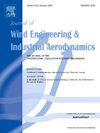台风条件下的中尺度到微尺度耦合模型,考虑了风电场的涡旋结构和科里奥利效应
IF 4.2
2区 工程技术
Q1 ENGINEERING, CIVIL
Journal of Wind Engineering and Industrial Aerodynamics
Pub Date : 2024-10-13
DOI:10.1016/j.jweia.2024.105922
引用次数: 0
摘要
风电场台风诱发风速的精确模拟对于风力发电机组台风风险的精细化评估至关重要。中国东南沿海地区风力资源丰富,但同时也受到台风的严重威胁。台风是一种结构复杂、破坏力极强的天气系统,中尺度模型难以模拟其精细化的近地面风场进行风险评估。因此,本文提出了一种台风条件下的中尺度和微尺度耦合模型,用于模拟台风引起的风场风。耦合模型中考虑了科里奥利力,以反映台风由涡旋结构引起的旋转效应。提出了一种基于客观分析的耦合算法,用于构建耦合界面的边界条件,以考虑垂直方向和横风方向的流入变量变化。根据台风实地观测结果,校核了二方程湍流模型的模型常数,以更合理地模拟台风。结果表明,与中尺度模型相比,耦合模型模拟的风电场最大风速精度有所提高,绝对误差减少了 34%。本文章由计算机程序翻译,如有差异,请以英文原文为准。
A meso- to micro-scale coupled model under typhoon conditions considering vortex structure and coriolis effect for wind farms
Accurate simulations of typhoon-induced wind speeds on wind farms are crucial for the refined assessment of typhoon risks in wind turbines. Southeastern coastal area in China is rich in wind resources but is also severely threatened by typhoons. As an extremely destructive weather system with complex structures, the refined near-surface wind fields of typhoons are difficult to simulate by meso-scale models for risk assessment. Therefore, a coupled meso- and micro-scale model under typhoon conditions is proposed to simulate typhoon-induced winds on a wind farm. The Coriolis force is considered in the coupled model to reflect the rotating effect of typhoons caused by the vortex structure. A coupling algorithm based on objective analysis is proposed to construct boundary conditions at the coupling interface, to consider the variation of inflow variables in the vertical and cross-wind directions. Model constants of the two-equation turbulence model are calibrated based on typhoon field observations, to more reasonably simulate typhoons. A validation study is conducted, and the results show that the maximum wind speed on the wind farm simulated by the coupled model exhibits an increased accuracy compared with that of the meso-scale model, where the absolute error decreases by 34%.
求助全文
通过发布文献求助,成功后即可免费获取论文全文。
去求助
来源期刊
CiteScore
8.90
自引率
22.90%
发文量
306
审稿时长
4.4 months
期刊介绍:
The objective of the journal is to provide a means for the publication and interchange of information, on an international basis, on all those aspects of wind engineering that are included in the activities of the International Association for Wind Engineering http://www.iawe.org/. These are: social and economic impact of wind effects; wind characteristics and structure, local wind environments, wind loads and structural response, diffusion, pollutant dispersion and matter transport, wind effects on building heat loss and ventilation, wind effects on transport systems, aerodynamic aspects of wind energy generation, and codification of wind effects.
Papers on these subjects describing full-scale measurements, wind-tunnel simulation studies, computational or theoretical methods are published, as well as papers dealing with the development of techniques and apparatus for wind engineering experiments.

 求助内容:
求助内容: 应助结果提醒方式:
应助结果提醒方式:


